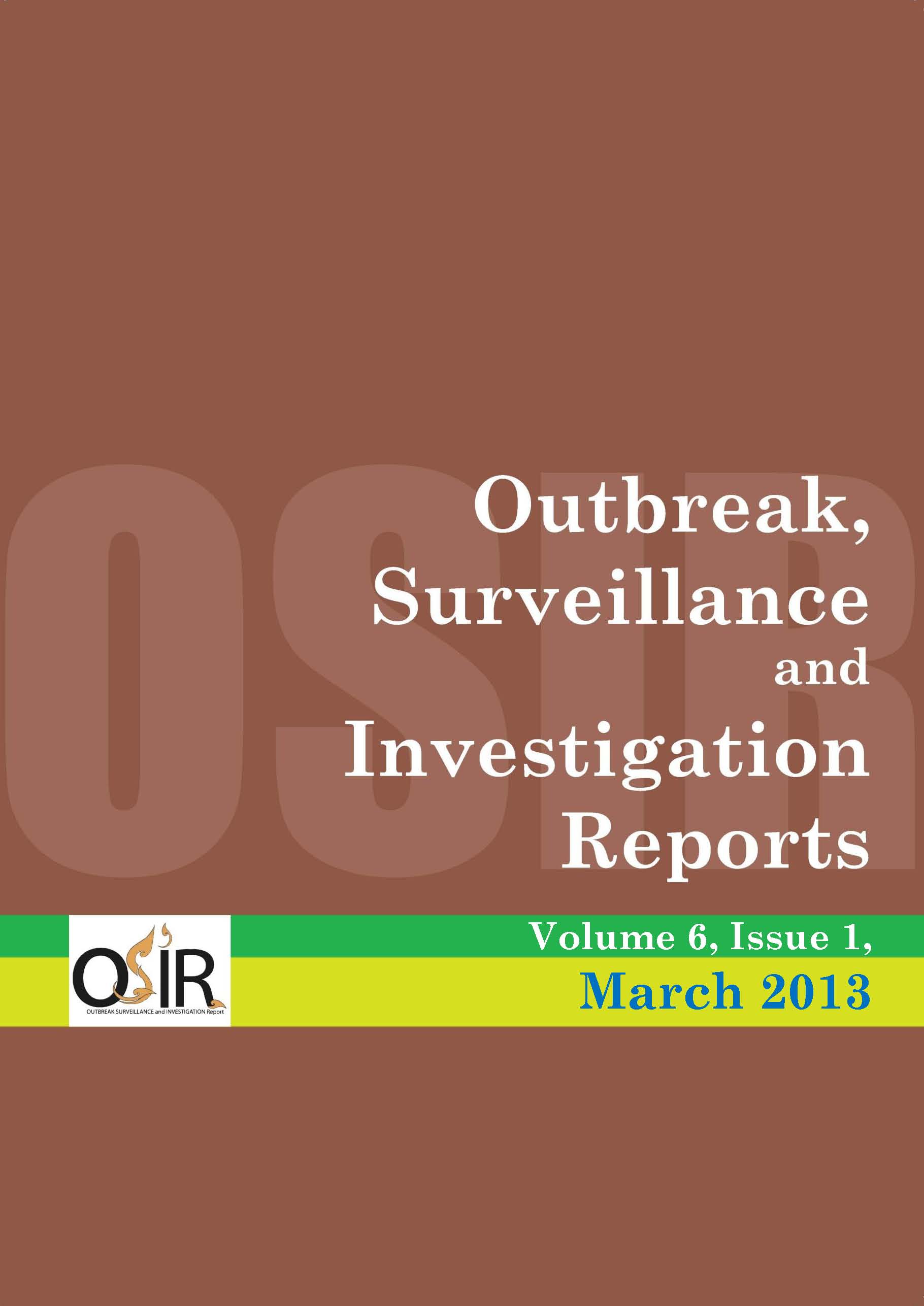Investigation on a Dog Rabies Case and Rabid Dog Meat Consumption, Nakhon Phanom Province, Thailand, 2011
DOI:
https://doi.org/10.59096/osir.v6i1.263339Keywords:
rabies, dog, dog meat consumption, KAP, Nakhon PhanomAbstract
In March 2011, public fear on health risk of rabid dog meat consumption was emerged in Nakhon Phanom Province. Investigation was conducted to identify extent of exposure and recommendation for rabies prevention. We surveyed in affected villages to find out rabies cases and exposed contacts among dogs, cats and humans. Persons who had contacted with the rabid dog, its carcass or meat were interviewed about their contacts, knowledge, attitudes and practices (KAP) towards rabies. The survey revealed that three owned dogs had been bitten by the rabid dog and 58 persons contacted it. Among the contact persons, 11.3% (bitten by the rabid dog, contact with carcass or saliva, butchered or cooked) and 19.0% (contacted dogs bitten by the rabid dog) fit in the WHO criteria as exposed and possible exposed persons respectively. Thirty two persons who ate well cooked meat of the rabid dog were classified as non-exposed persons. One third of the contact persons did not know about rabies. Persons who ate rabid dog meat had less knowledge on rabies reservoir and transmission compared with those did not eat (P-value <0.05). Contact persons and dogs were provided with post-exposure vaccination; none of them developed rabies. Several types of exposure, except ingesting well cooked meat, posed risk of rabies and local public should be educated about these for better personal protective practices.
References
World Organisation for Animal Health. Rabies a priority for humans and animals. OIE Bulletin. 2011;3. [cited 5 Feb 2013] <http://www.oie.int/fileadmin/Home/eng/Publications_%26_Documentation/docs/pdf/bulletin/Bull_2011-3-ENG.pdf>
The Center for Food Security and Public Health. Rabies and rabies-related Lyssaviruses. 2012 Nov. [cited 5 Feb 2013]. <http://www.cfsph.iastate.edu/Factsheets/pdfs/rabies.pdf>
Wertheim HF, Nguyen TQ, Nguyen KA, de Jong MD, Taylor WR, Le TV, et al. Furious rabies after an atypical exposure. PLoS Med. 2009 Mar 17;6(3):e44. [cited 5 Feb 2013] <http://www.ncbi.nlm.nih.gov/pmc/articles/PMC2656546/>
Tepsumethanon V, Wilde H, Meslin FX. Six criteria for rabies diagnosis in living dogs. J Med Assoc Thai. 2005 Mar;88(3):419-22.
World Health Organization. Rabies surveillance. [cited 5 Feb 2013].
Matibag GC, Kamigaki T, Kumarasiri PV, Wijewardana TG, Kalupahana AW, Dissanayake DR, et al. Knowledge, attitudes, and practices survey of rabies in a community in Sri Lanka. Environ Health Prev Med. 2007 Mar;12(2):84-9.
Centers for Disease Control and Prevention. Epi Info. [cited 5 Feb 2013]. <http://wwwn.cdc.gov/epiinfo/>
Kasempimolporn S, Jitapunkul S, Sitprija V. Moving towards the elimination of rabies in Thailand. J Med Assoc Thai. 2008 Mar;91(3):433-7.
Puanghat A, Hunsoowan W. Rabies situation in Thailand. J Med Assoc Thai. 2005 Sep;88(9):1319-22. Thai.
Nakhon Phanom Provincial Health Office. Haman rabies situation in Nakhon Phanom. 2011.
World Health Organization, Regional Office for South-East Asia. Rabies in the South-East Asia Region. p. 9. [cited 5 Feb 2013]. <http://209.61.208.233/LinkFiles/CDS_rabies.pdf.pdf>
National Association of State Public Health Veterinarians, Inc. Compendium of animal rabies prevention and control, 2011. MMWR Recomm Rep. 2011 Nov 4;60(RR-6):1-17.
Hanlon CA, Niezgoda M, Rupprecht CE. Postexposure prophylaxis for prevention of rabies in dogs. Am J Vet Res. 2002 Aug;63(8):1096-100.
Wilson PJ, Oertli EH, Hunt PR, Sidwa TJ. Evaluation of a postexposure rabies prophylaxis protocol for domestic animals in Texas: 2000-2009. J Am Vet Med Assoc. 2010 Dec 15;237(12):1395-401.
Downloads
Published
How to Cite
Issue
Section
License
Copyright (c) 2023 Outbreak, Surveillance, Investigation & Response (OSIR) Journal

This work is licensed under a Creative Commons Attribution-NonCommercial-NoDerivatives 4.0 International License.








